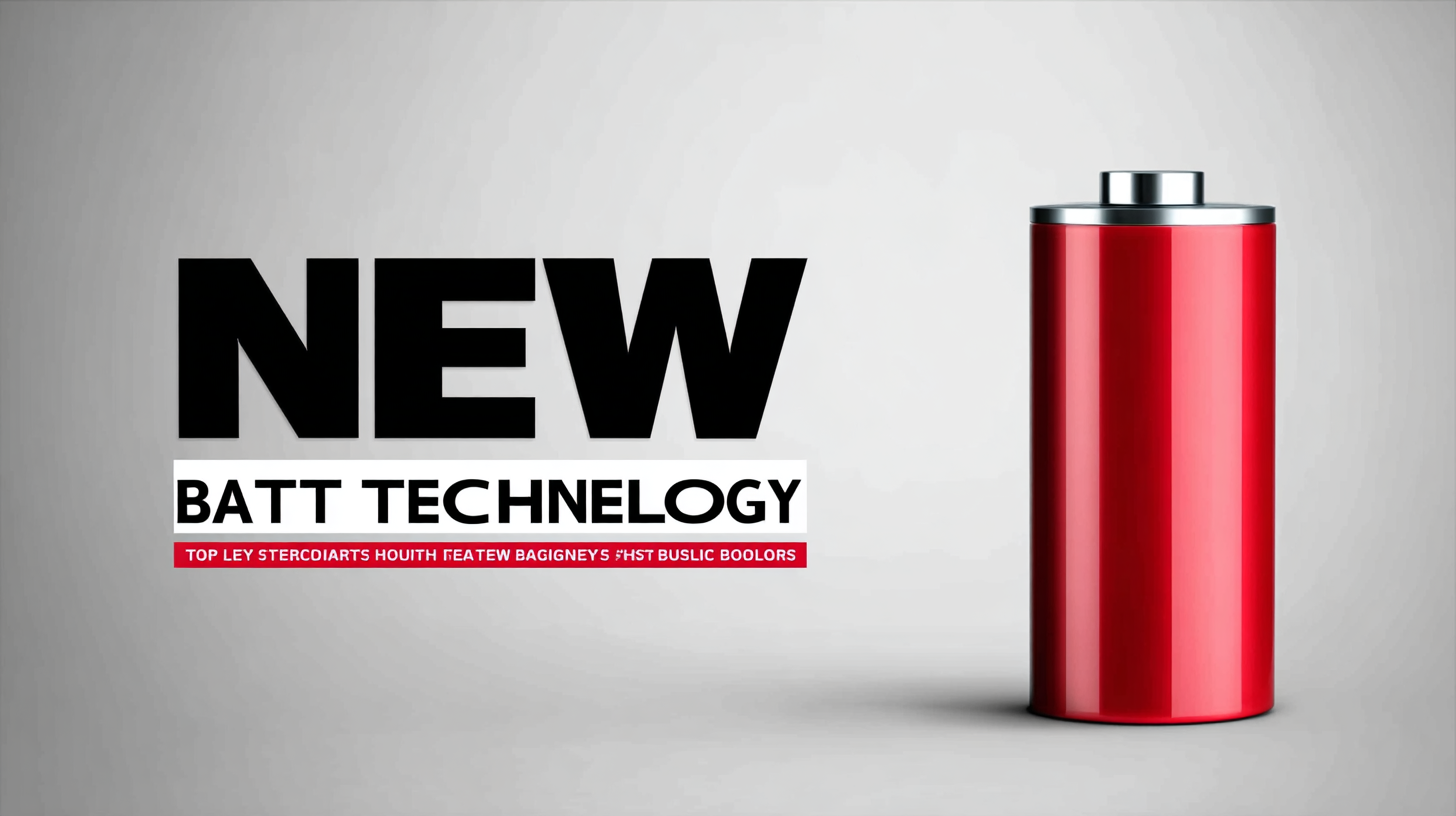Top Strategies for Leveraging Best New Battery Technology in Your Business
As industries increasingly shift towards sustainability and efficiency, the adoption of New Battery Technology has become a pivotal factor in enhancing business operations. According to a report by the International Energy Agency, the global demand for batteries is projected to increase sixfold by 2030, primarily driven by the electric vehicle market and renewable energy storage solutions. This surge underscores the importance of integrating advanced battery technologies into business models, as they not only offer significant cost savings in maintenance and after-sales services but also contribute to improved operational efficiency. By capitalizing on innovative battery solutions, companies can streamline their supply chains, reduce downtime, and enhance customer satisfaction, thus achieving a competitive edge in an ever-evolving market landscape.

Exploring the Latest Advances in Battery Technology for Business Applications
In recent years, advancements in battery technology have transformed the landscape for business applications, particularly with the rise of solid-state batteries. The global solid-state battery market, valued at approximately $98.96 million in 2024, is projected to expand significantly, reaching an estimated $1.36 billion by 2032. This considerable growth highlights the increasing demand for innovative energy storage solutions that provide enhanced efficiency and safety for various applications, including electric vehicles and portable electronics.
For businesses, leveraging these latest advancements in battery technology can lead to substantial operational improvements. Next-generation batteries are not only becoming essential for energy storage systems but are also seen as ripe for investment opportunities that can support growing grid energy storage demands. Enterprises focusing on industrial applications, such as forklifts and renewable energy solutions, can benefit from the capabilities of innovative battery technologies, thereby enhancing their competitiveness in the market. As companies like Piersica, Inc. continue to secure funding for the development of solid-state batteries, the ripple effects of this technology are set to drive transformational changes across multiple sectors.
Identifying the Right Battery Solutions for Your Industry Needs
As businesses increasingly seek to optimize efficiency and reduce their environmental impact, identifying the right battery solutions tailored to industry needs has become paramount. The first step in this process is understanding the specific energy requirements of your organization. For instance, industries such as renewable energy and electric vehicles may benefit significantly from advanced lithium-ion technology, which offers high energy density and longer life cycles. On the other hand, sectors like grid storage or heavy machinery may find that emerging solid-state batteries provide enhanced safety and performance, making them a better fit.

Additionally, it’s crucial to consider the scalability and adaptability of battery solutions. Industries that are rapidly evolving, such as consumer electronics or telecommunication, require flexible battery technologies that can keep pace with advancements and shifts in demand. Companies should also evaluate suppliers who provide comprehensive support and integration services, ensuring a smooth transition to new technologies. By taking a strategic approach to assessing battery technologies, businesses can significantly enhance their operational efficiency while aligning with sustainability goals.
Implementing Sustainable Practices with New Battery Technologies
As businesses increasingly focus on sustainability, integrating new battery technologies into operations offers a promising solution. These advancements not only enhance energy efficiency but also align with corporate social responsibility goals. Companies can leverage these technologies to reduce their carbon footprint while gaining a competitive edge.
Tip: Consider investing in modular battery systems that allow for easy scalability. This flexibility enables businesses to start small and expand as demand grows without needing a complete overhaul. Moreover, modular systems often promote quicker deployment and reduced waste.
Another strategy involves utilizing second-life batteries, which can be repurposed for energy storage in commercial settings. This practice not only maximizes resource use but also diminishes battery waste, transforming an environmental challenge into a sustainable opportunity.
Tip: Conduct a lifecycle assessment of your current energy systems to identify areas where new battery technologies could replace traditional energy sources. By doing so, you can pinpoint potential cost savings and improve overall sustainability, leading to a greener and more efficient business model.
Top Strategies for Leveraging Best New Battery Technology in Your Business - Implementing Sustainable Practices with New Battery Technologies
| Strategy | Benefits | Implementation Requirements | Sustainability Impact |
|---|---|---|---|
| Investment in Solid-State Batteries | Higher energy density and safety | R&D budget, partnership with battery manufacturers | Reduction in hazardous waste |
| Utilizing Virtual and Actual Battery Recycling Programs | Cost savings on raw materials | Collaboration with recycling facilities | Lower carbon footprint |
| Implementing Battery Management Systems | Extended battery life and efficiency | Investment in software and training | Decreased environmental impact |
| Adopting Renewable Energy Sources for Charging | Reduced operational costs | Infrastructure upgrades for solar/wind | Utilization of green energy |
| Exploring Advanced Lithium-ion Alternatives | Improved performance in various conditions | Testing and development facilities | Reduction in resource depletion |
Boosting Efficiency and Cost-Effectiveness through Innovative Battery Use
 Innovative battery technology has transformed the landscape of business operations, presenting opportunities to enhance efficiency and reduce costs significantly. Companies can leverage cutting-edge batteries, such as lithium-sulfur and solid-state options, which offer higher energy densities and longer lifespans compared to traditional lithium-ion batteries. By integrating these advanced power solutions into their operations, businesses can power equipment more reliably, ultimately minimizing downtime and maintenance costs. This ensures that resources are allocated more effectively, leading to improved overall productivity.
Innovative battery technology has transformed the landscape of business operations, presenting opportunities to enhance efficiency and reduce costs significantly. Companies can leverage cutting-edge batteries, such as lithium-sulfur and solid-state options, which offer higher energy densities and longer lifespans compared to traditional lithium-ion batteries. By integrating these advanced power solutions into their operations, businesses can power equipment more reliably, ultimately minimizing downtime and maintenance costs. This ensures that resources are allocated more effectively, leading to improved overall productivity.
Moreover, the adoption of new battery technologies can facilitate a shift towards sustainability in business practices. With environmentally friendly innovations, businesses not only reduce their carbon footprint but also potentially attract eco-conscious consumers. Implementing energy storage systems powered by these advanced batteries can allow companies to harness renewable energy sources, such as solar and wind, storing excess power for later use. This not only stabilizes energy costs but also aligns with global sustainability goals, positioning businesses as leaders in their industries and enhancing their reputation among stakeholders. As firms continue to explore the full potential of innovative battery solutions, the impacts on operational efficiency and cost-effectiveness will be **profound**.
Future Trends: Preparing Your Business for the Next Generation of Battery Innovations
As we look toward the future of battery technology, businesses must be proactive in adapting to the industry's rapid advancements. The global solid-state battery market is projected to reach a value of $98.96 million by 2024, with expectations of growth to $119 million in 2025 and a remarkable increase to $1.3598 billion by 2032. This explosive growth signals a pivotal transition in energy storage technology, presenting unique opportunities for businesses to innovate and enhance their product offerings.
Key to leveraging these advancements is the ability to integrate new battery technologies into existing operations. For instance, the recent World New Energy Vehicle Conference highlighted the importance of collaboration within the automotive ecosystem, emphasizing sustainable development through technological innovation. By aligning with the latest trends, businesses can not only optimize their operational efficiency but also meet the increasing demand for cleaner, more efficient energy sources. Embracing these innovations will be critical for businesses aiming to stay competitive and capitalize on the burgeoning market for next-generation battery technologies.
